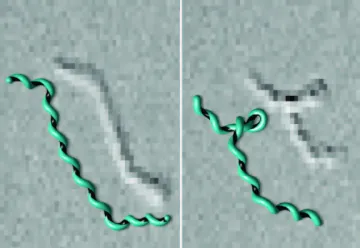Bacteria research by Prof. Wolgemuth's group chosen as Editor’s Suggestion in PRL and featured in Physics Magazine

Prof. Charles Wolgemuth (left) and Dr. Paul Ryan (right)
Research performed by Professor Charles Wolgemuth and former physics graduate student Dr. Paul Ryan on the mechanism used by spiroplasma bacteria to swim was published in Physical Review Letters today, and was highlighted as an Editor's Suggestion and featured in APS Physics Magazine.
Spiroplasma is an enigmatic, helical bacterium that swims by repeatedly flipping the handedness of its body shape. How it is able to generate these helical inversions remains a mystery. Physically, there are two different ways to make a helix. Take a filament, bend it and then twist it; or bend the filament into a planar wave, and then bend it similarly along the perpendicular direction, but shifted by a ¼ wavelength. While both of these methods produce similar looking helices, they were created differently. Consequently, they will behave differently. Simulations carried out in the Wolgemuth group suggested that increasing the viscosity would cause Spiroplasma to tie itself into a plectoneme (the shape of an overtwisted phone cord). Then, they used experiments to show that whatever Spiroplasma is doing must use bending, not twisting, motions. These findings shed new light on the mechanism that Spiroplasma uses to swim, while also highlighting fundamental features of the dynamics of filaments.

Observations and computer simulations of spiroplasma plectoneme formation



